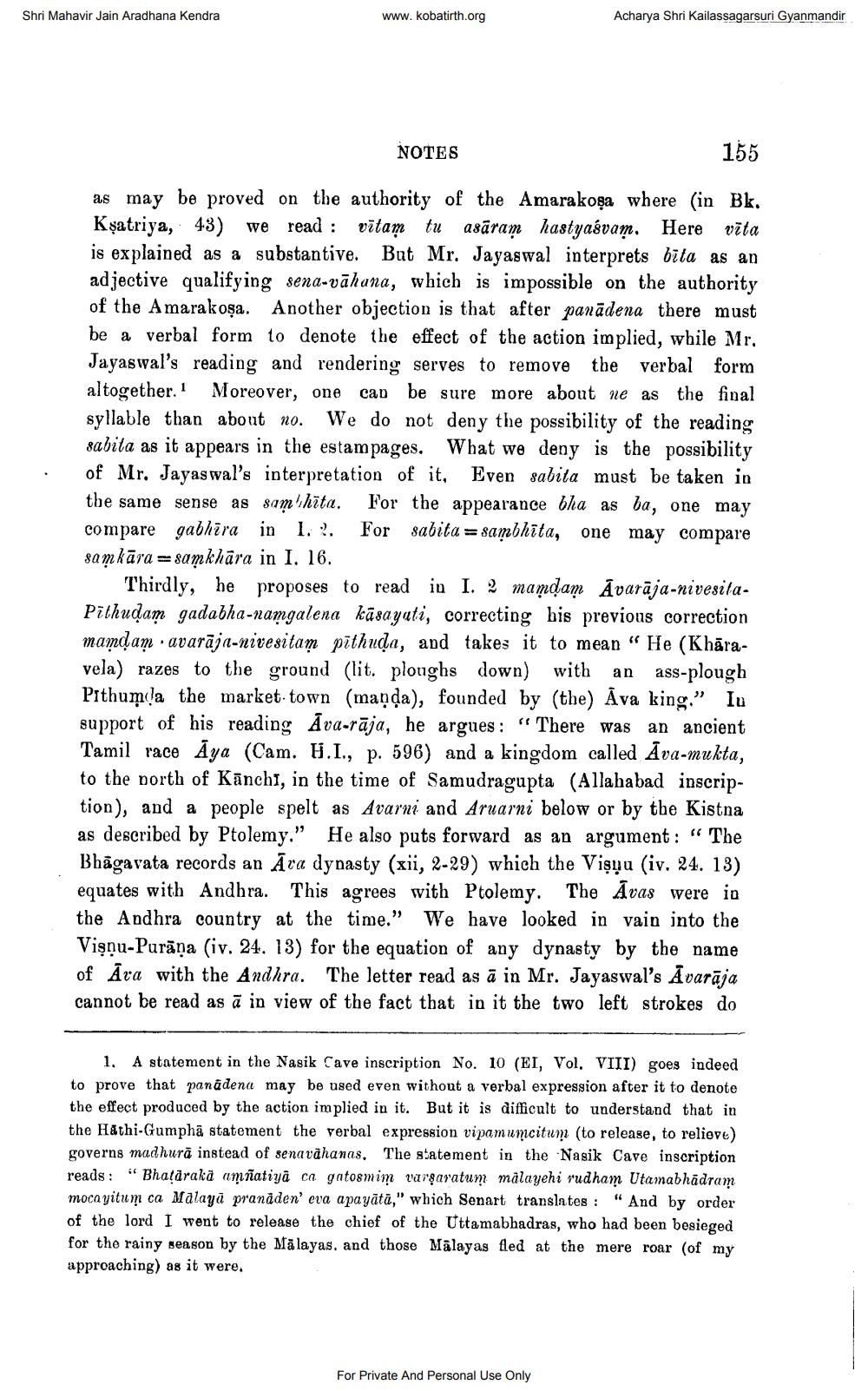________________
Shri Mahavir Jain Aradhana Kendra
www.kobatirth.org
Acharya Shri Kailassagarsuri Gyanmandir
NOTES
155
as may be proved on the authority of the Amarakoşa where (in Bk. Kșatriya, 43) we read : vitam tu asāram hastyasvam. Here vita is explained as a substantive. But Mr. Jayaswal interprets bīta as an adjective qualifying sena-vāhana, which is impossible on the authority of the Amarakosa. Another objection is that after panādena there must be a verbal form to denote the effect of the action implied, wbile Mr. Jayaswal's reading and rendering serves to remove the verbal form altogether. Moreover, one can be sure more about ne as the final syllable than about no. We do not deny the possibility of the reading sabita as it appears in the estampages. What we deny is the possibility of Mr. Jayaswal's interpretation of it. Even sabita must be taken in the same sense as sam hita. For the appearance bha as ba, one may compare gabhira in 1. 2. For sabita = sambhita, one may compare samkāra = samkhāra in I. 16.
Thirdly, he proposes to read in I. 2 mamờam Avarāja-nivesitaPithudam gadabha-namgalena kāsayati, correcting his previous correction mamdam · avarāja-nivesitam pithuda, and takes it to mean “He (Khāravela) razes to the ground (lit. ploughs down) with an ass-plough Pothumla the market town (maņņa), founded by (the) Āva king." Iu support of his reading Āva-rāja, he argues : " There was an ancient Tamil race Āya (Cam. H.I., p. 596) and a kingdom called Āva-mukta, to the north of Kānchi, in the time of Samudragupta (Allahabad inscription), and a people spelt as Avarni and Aruarni below or by the Kistna as described by Ptolemy." He also puts forward as an argument: “ The Bhāgavata records an Āra dynasty (xii, 2-29) which the Vişnu (iv. 24. 13) equates with Andhra. This agrees with Ptolemy. The Āvas were in the Andhra country at the time." We have looked in vain into the Vişnu-Purāņa (iv. 24. 13) for the equation of any dynasty by the name of Āra with the Andhra. The letter read as ā in Mr. Jayaswal's Avarāja cannot be read as ā in view of the fact that in it the two left strokes do
1. A statement in the Nasik Cave inscription No. 10 (EI, Vol. VIII) goes indeed to prove that panadena may be used even without a verbal expression after it to denote the effect produced by the action implied in it. But it is difficult to understand that in the Hathi-Gumphā statement the verbal expression vipamumcitum (to release, to relieve) governs madhurā instead of senavahanas. The statement in the Nasik Cave inscription reads: "Bhatáraka amñatiya ca gatosmim varsaratum målayehi rudham Utamabhädram moca yitum ca Malayā pranăden' eva apayātā,” which Senart translates : " And by order of the lord I went to release the chief of the Uttamabhadras, who had been besieged for the rainy season by the Mālayas, and those Mālayas fled at the mere roar (of my approaching) as it were.
For Private And Personal Use Only




